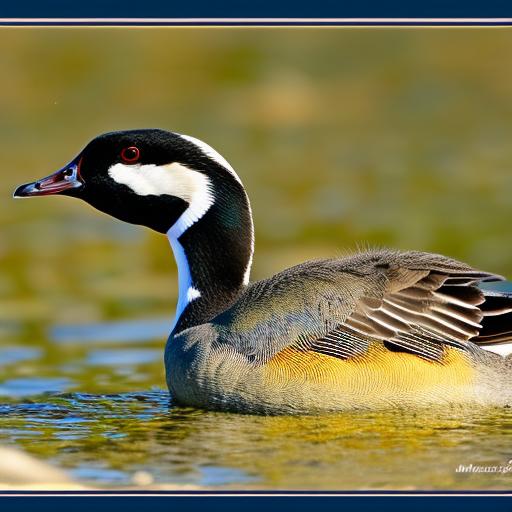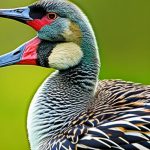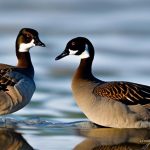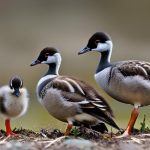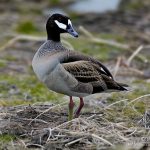Canada Geese are a familiar sight in many parts of North America, known for their distinctive honking calls and V-shaped flight formations. These large waterfowl are also known for their breeding habits, which are a fascinating and important part of their lifecycle. Breeding season for Canada Geese typically begins in late winter or early spring, when the birds return to their nesting grounds after spending the winter in warmer areas. During this time, they engage in courtship behaviors, select nesting sites, lay eggs, and care for their young. Understanding the breeding habits of Canada Geese is important for conservation efforts and for managing human-wildlife interactions.
Courtship Behavior of Canada Geese
The courtship behavior of Canada Geese is a complex and fascinating process. It typically begins with the formation of pair bonds between males and females, which can last for life. During courtship, the geese engage in a variety of displays and vocalizations to attract a mate and reinforce their bond. These displays can include head bobbing, neck stretching, and honking calls. Once a pair bond is established, the geese will begin to search for a suitable nesting site. Understanding the courtship behavior of Canada Geese is important for conservation efforts, as disturbances during this critical time can disrupt the breeding process and reduce reproductive success.
Nesting Habits and Site Selection
Canada Geese are known for their strong nesting instincts and will often return to the same nesting site year after year. Nesting sites are typically located near water, such as lakes, ponds, or marshes, and provide protection from predators. The geese will often build their nests on the ground, using a variety of materials such as grass, reeds, and twigs. They may also use man-made structures such as nesting platforms or even rooftops. Nesting site selection is an important part of the breeding process, as it can impact the survival of the eggs and goslings. Understanding the nesting habits and site selection of Canada Geese is important for conservation efforts, as disturbances to nesting sites can have a negative impact on breeding success.
Egg Laying and Incubation Period
Once a nesting site is selected, the female Canada Goose will lay a clutch of eggs, typically ranging from 4 to 8 eggs. The eggs are a pale green or off-white color and are incubated by the female for around 25-28 days. During this time, the male will stand guard and protect the nesting female from potential threats. Incubation is a critical time for the geese, as disturbances or disruptions to the nesting site can result in the loss of eggs or reduced hatching success. Understanding the egg laying and incubation period of Canada Geese is important for conservation efforts, as it can help to identify and mitigate potential threats to breeding success.
Parental Care and Protection of Goslings
Once the eggs hatch, the goslings are precocial, meaning they are able to leave the nest and feed themselves shortly after hatching. The parents will lead the goslings to water, where they will learn to swim and forage for food. The adults will also provide protection from predators and other threats, often using vocalizations and physical displays to ward off potential dangers. Parental care and protection of goslings is a critical part of the breeding process, as it can impact the survival and growth of the young birds. Understanding the parental care and protection of goslings is important for conservation efforts, as it can help to identify and mitigate potential threats to breeding success.
Hatching and Development of Goslings
The hatching and development of goslings is a fascinating and important part of the breeding process for Canada Geese. Once the eggs hatch, the goslings are covered in down and are able to walk, swim, and feed themselves shortly after hatching. The parents will lead the goslings to water, where they will learn to swim and forage for food. The adults will also provide protection from predators and other threats, often using vocalizations and physical displays to ward off potential dangers. As the goslings grow, they will begin to develop their flight feathers and will eventually fledge, or leave the nest, to join the rest of the flock. Understanding the hatching and development of goslings is important for conservation efforts, as it can help to identify and mitigate potential threats to breeding success.
Feeding and Foraging Behavior of Breeding Geese
During the breeding season, Canada Geese will forage for a variety of foods, including grasses, sedges, and aquatic plants. They may also feed on agricultural crops such as wheat, barley, and corn. The geese will often graze in open fields or on the edges of water bodies, using their powerful bills to pull up and consume vegetation. Understanding the feeding and foraging behavior of breeding geese is important for conservation efforts, as it can help to identify and mitigate potential conflicts with agricultural interests and other human-wildlife interactions.
Challenges and Threats to Breeding Canada Geese
Breeding Canada Geese face a variety of challenges and threats, including habitat loss, predation, and human disturbances. Loss of nesting sites due to development or habitat destruction can impact breeding success, as can disturbances from human activities such as boating, fishing, and recreational activities. Predators such as foxes, raccoons, and gulls can also pose a threat to nesting geese and their eggs. Understanding the challenges and threats to breeding Canada Geese is important for conservation efforts, as it can help to identify and mitigate potential impacts on breeding success.
Conservation and Management of Breeding Geese Populations
Conservation and management of breeding Canada Geese populations is an important part of wildlife management and habitat protection. Efforts to conserve breeding geese may include habitat restoration, protection of nesting sites, and management of human-wildlife interactions. Conservation efforts may also include monitoring of breeding populations, research on breeding habits and behaviors, and public education and outreach. Understanding the conservation and management of breeding geese populations is important for ensuring the long-term survival and health of these iconic waterfowl.
The Importance of Understanding the Lifecycle of Canada Geese Breeding
In conclusion, understanding the lifecycle of Canada Geese breeding is important for conservation efforts and for managing human-wildlife interactions. From courtship behavior and nesting habits to parental care and feeding behavior, the breeding process of Canada Geese is a complex and fascinating part of their lifecycle. By understanding the challenges and threats to breeding success, as well as the conservation and management of breeding populations, we can work to ensure the long-term survival and health of these iconic waterfowl. Through research, monitoring, and public education, we can help to protect and preserve the breeding habitats and populations of Canada Geese for future generations to enjoy.
Meet Walter, the feathered-friend fanatic of Florida! Nestled in the sunshine state, Walter struts through life with his feathered companions, clucking his way to happiness. With a coop that’s fancier than a five-star hotel, he’s the Don Juan of the chicken world. When he’s not teaching his hens to do the cha-cha, you’ll find him in a heated debate with his prized rooster, Sir Clucks-a-Lot. Walter’s poultry passion is no yolk; he’s the sunny-side-up guy you never knew you needed in your flock of friends!

